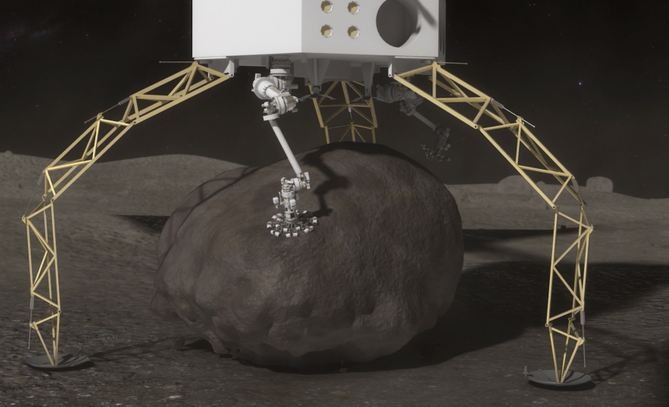It's now accepted dogma at NASA that any manned landing on Mars will be preceded by a manned landing on a large asteroid. And this asteroid landing will be preceded by capturing a small asteroid and making it orbit the Moon.
NASA today announced it will push through with its incredible Asteroid Redirect Mission (ARM), also known as the Asteroid Retrieval and Utilization mission that will bring a small near-Earth asteroid into lunar orbit where it will be further analyzed both by unmanned craft and by a future manned mission.
The ARM spacecraft, as yet unnamed, will be built with a large, 15 meter (50 feet) capture bag capable of holding an asteroid up to 8 meters (26 feet) in diameter.
The spacecraft will be equipped with Hall-effect ion thrusters for propulsion. These thrusters fire at low acceleration but can fire for many years to move the spacecraft at high speed. These engines will be powered by ring-shaped solar panels.
NASA hopes to complete the ARM mission, which may take from six to 10 years, in time to accomplish its goal of landing humans on an asteroid by 2026.
NASA Administrator Charles Bolden previously said ARM "represents an unprecedented technological feat that will lead to new scientific discoveries and technological capabilities and help protect our home planet."
ARM, which will cost up to US$1.25 billion, is to launch in December 2020. Its likely target will be an asteroid identified as 2008 EV5, which is a quarter of a mile in size.
It will take about two years for a spacecraft to reach and land on the asteroid. The spacecraft will linger on the asteroid for up to 400 days as it searches for a good boulder.
NASA said the ideal boulder might be some 13 feet in diameter. The spacecraft will then capture this boulder and fly to the Moon, where it will release the rock into Moon orbit.
In 2025, astronauts on NASA's Orion spacecraft to dock with the asteroid-carrying spacecraft and study the rock up close.
The main goal of ARM is to serve as a testing ground for a Mars mission. ARM will give NASA a chance to practice the precise navigation and maneuvering techniques its astronauts will need to master for a Mars mission.
The spacecraft will also test a solar electronic propulsion system that will use the power from solar panels to propel charged particles to provide thrust. This type of propulsion is much less powerful than conventional chemical rockets but a lot more efficient.




























